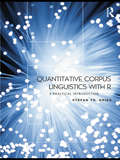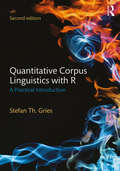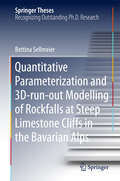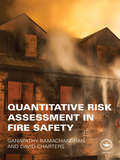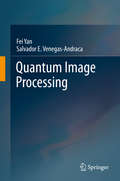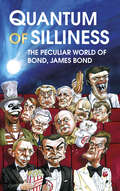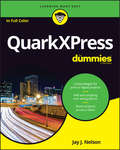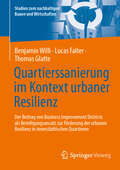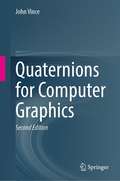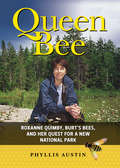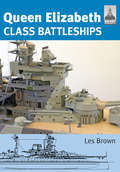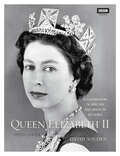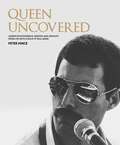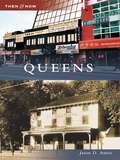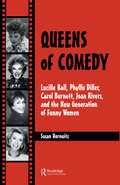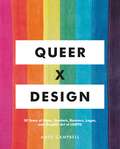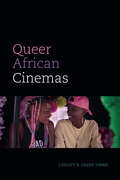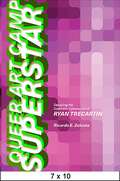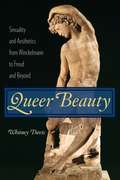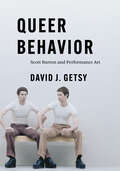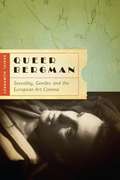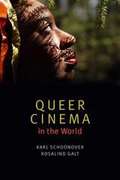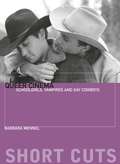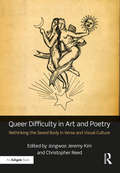- Table View
- List View
Quantitative Corpus Linguistics with R: A Practical Introduction
by Stefan Th. GriesThe first textbook of its kind, Quantitative Corpus Linguistics with R demonstrates how to use the open source programming language R for corpus linguistic analyses. Computational and corpus linguists doing corpus work will find that R provides an enormous range of functions that currently require several programs to achieve – searching and processing corpora, arranging and outputting the results of corpus searches, statistical evaluation, and graphing.
Quantitative Corpus Linguistics with R: A Practical Introduction
by Stefan Th. GriesAs in its first edition, the new edition of Quantitative Corpus Linguistics with R demonstrates how to process corpus-linguistic data with the open-source programming language and environment R. Geared in general towards linguists working with observational data, and particularly corpus linguists, it introduces R programming with emphasis on: data processing and manipulation in general; text processing with and without regular expressions of large bodies of textual and/or literary data, and; basic aspects of statistical analysis and visualization. This book is extremely hands-on and leads the reader through dozens of small applications as well as larger case studies. Along with an array of exercise boxes and separate answer keys, the text features a didactic sequential approach in case studies by way of subsections that zoom in to every programming problem. The companion website to the book contains all relevant R code (amounting to approximately 7,000 lines of heavily commented code), most of the data sets as well as pointers to others, and a dedicated Google newsgroup. This new edition is ideal for both researchers in corpus linguistics and instructors who want to promote hands-on approaches to data in corpus linguistics courses.
Quantitative Parameterization and 3D-run-out Modelling of Rockfalls at Steep Limestone Cliffs in the Bavarian Alps
by Bettina SellmeierThis pioneering work deals with the parameterization of rockfalls in the context of 3D run-out modelling at a study site in the Bavarian Alps. The main objective was to cover not only low-magnitude, high-frequency rockfalls (
Quantitative Risk Assessment in Fire Safety
by Ganapathy Ramachandran David ChartersFire safety regulations in many countries require Fire Risk Assessment to be carried out for buildings such as workplaces and houses in multiple occupation. This duty is imposed on a "Responsible Person" and also on any other persons having control of buildings in compliance with the requirements specified in the regulations. Although regulations only require a qualitative assessment of fire risk, a quantitative assessment is an essential first step for performing cost-benefit analysis of alternative fire strategies to comply with the regulations and selecting the most cost-effective strategy. To facilitate this assessment, various qualitative, semi-quantitative and quantitative techniques of fire risk assessment, already developed, are critically reviewed in this book and some improvements are suggested. This book is intended to be an expanded version of Part 7: Probabilistic risk assessment, 2003, a Published Document (PD) to British Standard BS 7974: 2001 on the Application of Fire Safety Engineering Principles to the Design of Buildings. Ganapathy Ramachandran and David Charters were co-authors of PD 7974 Part 7. Quantitative Risk Assessment in Fire Safety is essential reading for consultants, academics, fire safety engineers, fire officers, building control officers and students in fire safety engineering. It also provides useful tools for fire protection economists and risk management professionals, including those involved in fire insurance underwriting.
Quantum Image Processing
by Fei Yan Salvador E. Venegas-AndracaThis book provides a comprehensive introduction to quantum image processing, which focuses on extending conventional image processing tasks to the quantum computing frameworks. It summarizes the available quantum image representations and their operations, reviews the possible quantum image applications and their implementation, and discusses the open questions and future development trends. It offers a valuable reference resource for graduate students and researchers interested in this emerging interdisciplinary field.
Quantum of Silliness: The Peculiar World of Bond, James Bond
by Robbie SimsWho gives the hammiest performance in a Bond film? What is the series’ most cringeworthy moment? What quips would Sir Roger Moore come out with if he starred in Licence to Kill? These are the sort of questions you never knew you needed answering. It’s Bond, James Bond – but as you’ve never seen him before.
QuarkXPress For Dummies
by Jay J. NelsonTake the kinks out of working with QuarkXPress QuarkXPress still remains one of the top tools for layout and design projects, even thirty years after it made its debut. This full-color, hands-on guide is here to help you take the guesswork out of using this powerful tool to create stunning print or digital designs. In QuarkXPress For Dummies, you'll find information on the latest changes to QuarkXPress, easy-to-follow, step-by-step guidance on using the tools built into the software to aid in designing and outputting visual product, and quick solutions to common Quark problems when you get stuck. QuarkXPress dominated the page layout world for decades. It's stuck around thanks to how it readily adapts to customer needs. This new version contains updates and features driven solely by customer feedback. That responsiveness is luring new and former users to the fold. That resurgence in the design community has Quark users clamoring for an authoritative book on how to use it to its fullest. Created in partnership with the pros at Quark, this is the book for new and experienced QuarkXPress users looking to make sense of the latest version. Offers unbeatable tricks for working with text Provides guidance on managing larger design projects Includes tips on how to correct mistakes Take a tour of the palettes, add style to your work, and make QuarkXPress work for you!
Quartierssanierung im Kontext urbaner Resilienz: Der Beitrag von Business Improvement Districts als Beteiligungsansatz zur Förderung der urbanen Resilienz in innerstädtischen Quartieren (Studien zum nachhaltigen Bauen und Wirtschaften)
by Thomas Glatte Lucas Falter Benjamin WilliStädte und ihre Quartiere sind Transformationsprozessen unterworfen und stehen nach Krisen wie der Corona-Pandemie vor großen Herausforderungen. Diese Publikation aus der Reihe „Studien zum nachhaltigen Bauen und Wirtschaften” untersucht in welcher Konstellation und unter welchen Bedingungen Business Improvement Districts (BIDs) als ein Beteiligungsinstrument der Quartiersentwicklung für die Stärkung der urbanen Resilienz eingesetzt werden können. Dabei wird auch der Frage nachgegegangen wer für die Umsetzung resilienter Stadtentwicklung verantwortlich ist und was konkret in einem Quartier resilient gestaltet werden soll.
Quaternions for Computer Graphics
by John VinceIf you have ever wondered what quaternions are — then look no further, John Vince will show you how simple and useful they are. This 2nd edition has been completely revised and includes extra detail on the invention of quaternions, a complete review of the text and equations, all figures are in colour, extra worked examples, an expanded index, and a bibliography arranged for each chapter. Quaternions for Computer Graphics includes chapters on number sets and algebra, imaginary and complex numbers, the complex plane, rotation transforms, and a comprehensive description of quaternions in the context of rotation. The book will appeal to students of computer graphics, computer science and mathematics, as well as programmers, researchers, academics and professional practitioners interested in learning about quaternions. John Vince explains in an easy-to-understand language, with the aid of useful figures, how quaternions emerged, gave birth to modern vector analysis, disappeared, and reemerged to be adopted by the flight simulation industry and computer graphics. This book will give you the confidence to use quaternions within your every-day mathematics, and explore more advanced texts.
Queen Bee: Roxanne Quimby, Burt's Bees, and Her Quest for a New National Park
by Phyllis AustinIn this fascinating biography of the woman behind the wildly successful line of natural skin care products known as Burt's Bees, veteran journalist Phyllis Austin provides insight into Roxanne Quimby s background, her determination, and her desire to protect Maine s wilderness by establishing a national park in the north woods. Born in Massachusetts, Roxanne Quimby made herself a success. She changed a roadside honey stand into a juggernaut company worth hundreds of millions of dollars before selling it to Clorox in 2007. She then turned her attention to her longstanding interest: conservation. Quimby has purchased more than 120,000 acres of Maine forest to preserve it. Not everyone in the Katahdin region welcomed Quimby s efforts with open arms, and this well-researched book chronicles the ups and downs of Roxanne s quest for a national park in a way no other book has.
Queen Elizabeth Class Battleships (Shipcraft Ser. #15)
by Les BrownThe ShipCraft series provides in-depth information about building and modifying model kits of famous warship types. Lavishly illustrated, each book takes the modeller through a brief history of the subject class, highlighting differences between sister-ships and changes in their appearance over their careers. This includes paint schemes and camouflage, featuring colour profiles and highly detailed line drawings and scale plans. The modelling section reviews the strengths and weaknesses of available kits, lists commercial accessory sets for super-detailing of the ships, and provides hints on modifying and improving the basic kit. This is followed by an extensive photographic survey of selected high-quality models in a variety of scales, and the book concludes with a section on research references - books, monographs, large-scale plans and relevant websites.This volume covers the five ships of the highly successful Queen Elizabeth class, a design of fast battleship that set the benchmark for the last generation of dreadnoughts. Although they fought with distinction in WW1, all were thought valuable enough to be modernised between the wars - indeed, three were massively reconstructed, providing the modelmaker with a challenging variety of possible subjects.
Queen Elizabeth II: A Celebration of Her Life and Reign in Pictures
by David Souden BBC BooksThis lavish tribute to Britain&’s Queen Elizabeth II, produced in partnership with the BBC, celebrates her incredible life and legacy in more than 240 photos—including some never-before-seen images. The longest-reigning monarch in British history, Queen Elizabeth II was at the heart of British life for almost a century. She led a very public life, seen by millions through photographs, film, and television—from the time of her birth in 1926 to the final years of her reign. The embodiment of Britain, she was a constant, knowledgeable presence in British politics and culture since she came to the throne in 1952, through seven decades of change. This book celebrates the life of Queen Elizabeth II through photographs and stills, drawn largely from the archives of the BBC, the UK&’s national broadcaster, and an organization that received its royal charter only one year after she was born. From the Queen's earliest days and first moments of public life to her Diamond Jubilee and the weddings of her children and grandchildren—and a special section of photographs from the ceremonies surrounding her funeral and poignant images celebrating her legacy—this is a wonderful homage to the most public of monarchs, an iconic figure in the hearts and minds of millions throughout the world.
Queen Uncovered: Unseen Photographs, Rarities and Insights From Life With A Rock 'n' Roll Band
by Peter HincePeter Hince spent 13 years as head roadie for Queen. His collection of photographs and ephemera from the band&’s personal and public moments will finally see the light of day for the first time. It&’s a unique photographic record of one of the most celebrated rock bands of all time. From concerts in Munich to Japan, Hince follows Queen from studio to street to stage. Facsimiles of handwritten notes from recording sessions, photos of the band in the studio, images of cassettes given to Hince to debut at clubs, Freddie Mercury with and without a mustache . . . the list goes on. Along with many candid moments are great photos of the various items collected from more than a decade of tours: backstage passes, matchbooks, set lists, and more.
Queens (Then and Now)
by Jason D. AntosThe borough of Queens, New York, has seen many historical and geographical changes. Marshlands, woods, and farms gave way to factories, thriving communities, and the nation's premier arterial highway system. Queens offers a rare look at New York City's largest borough, featuring many never-before-seen images.
Queens of Comedy: Lucille Ball, Phyllis Diller, Carol Burnett, Joan Rivers, and the New Generation of Funny Women
by Susan HorowitzThrough candid personal interviews with Lucille Ball, Carol Burnett, and other visionary performers, Queens of Comedy explores how comediennes have redefined the roles of women in not only the entertainment business, but society as a whole. Detailing both their public and private lives - as well as their many and varied performances - Queen of Comedy examines the impact these women have had on the predominantly male-oriented world of comedy. Performers like Carol Burnett, Joan Rivers, and their more recent counterparts, comediennes Brett Butler and Roseanne, have helped to sift women's roles in comedy from object to subject. This book maps out this shift, providing an often brutally honest picture of women's lives in both the spotlight of comedy and this modern world.
Queer X Design: 50 Years of Signs, Symbols, Banners, Logos, and Graphic Art of LGBTQ
by Andy CampbellThe first-ever illustrated history of the iconic designs, symbols, and graphic art representing more than 5 decades of LGBTQ pride and activism--from the evolution of Gilbert Baker's rainbow flag to the NYC Pride typeface launched in 2017 and beyond.Organized by decade beginning with Pre-Liberation and then spanning the 1970s through the millennium, QUEER X DESIGN will be an empowering, uplifting, and colorful celebration of the hundreds of graphics-from shapes and symbols to flags and iconic posters-that have stood for the powerful and ever-evolving LGBTQ movement over the last five-plus decades. Included in the collection will be everything from Gilbert Baker's original rainbow flag, ACT-UP's Silence = Death poster, the AIDS quilt, and Keith Haring's "Heritage of Pride" logo, as well as the original Lavender Menace t-shirt design, logos such as "The Pleasure Chest," protest buttons such as "Anita Bryant Sucks Oranges," and so much more. Sidebars throughout will cover important visual grouping such as a "Lexicon of Pride Flags," explaining the now more than a dozen flags that represent segments of the community and the evolution of the pink triangle.
Queer African Cinemas (a Camera Obscura book)
by Lindsey B. Green-SimmsIn Queer African Cinemas, Lindsey B. Green-Simms examines films produced by and about queer Africans in the first two decades of the twenty-first century in an environment of increasing antiqueer violence, efforts to criminalize homosexuality, and other state-sanctioned homophobia. Green-Simms argues that these films not only record the fear, anxiety, and vulnerability many queer Africans experience; they highlight how queer African cinematic practices contribute to imagining new hopes and possibilities. Examining globally circulating international art films as well as popular melodramas made for local audiences, Green-Simms emphasizes that in these films queer resistance—contrary to traditional narratives about resistance that center overt and heroic struggle—is often practiced from a position of vulnerability. By reading queer films alongside discussions about censorship and audiences, Green-Simms renders queer African cinema as a rich visual archive that documents the difficulty of queer existence as well as the potentials for queer life-building and survival.
Queer Art Camp Superstar: Decoding the Cinematic Cyberworld of Ryan Trecartin (SUNY series, Horizons of Cinema)
by Ricardo E. ZuluetaHailed as "the most consequential artist to have emerged since the nineteen-eighties," American artist and filmmaker Ryan Trecartin has received numerous accolades for his kaleidoscopic, multilayered movies and multimedia installations. However, there exists to date no comprehensive study of this prolific artist's work. Queer Art Camp Superstar compensates for this absence of sustained critical analysis of Trecartin's work by looking closely at a selection of his most significant movies in order to discern the artist's artistic genealogy, evolving aesthetics, radical approach to digital and Internet culture, and impact on contemporary art, film, and media.Examining Trecartin's substantial body of work, spanning from his early, pre-YouTube era series Early Baggage (2001–2003) to Temple Time (2016), Ricardo E. Zulueta adheres to a faithful chronological order, thus inviting readers to witness the ways thematic and formal concerns have evolved from Trecartin's earliest movies to his more recent multimedia cinematic installations. Through precisely chosen screen captures extracted directly from the movies, Zulueta demonstrates the serious attention paid to camera angles, mise-en-scène, and shot transitions, thus revealing and reflecting on the concepts that underwrite and are underwritten in these narratives. Giving careful attention to Trecartin's network of layered references to the grotesque and abject, carnivalesque and ludic, and camp imagery, Zulueta illustrates and explains how the artist takes on reality television, technology, fashion, consumption, and cyberspace.
Queer Beauty: Sexuality and Aesthetics from Winckelmann to Freud and Beyond (Columbia Themes in Philosophy, Social Criticism, and the Arts)
by Whitney DavisThe pioneering work of Johann Winckelmann (1717-1768) identified a homoerotic appreciation of male beauty in classical Greek sculpture, a fascination that had endured in Western art since the Greeks. Yet after Winckelmann, the value (even the possibility) of art's queer beauty was often denied. Several theorists, notably the philosopher Immanuel Kant, broke sexual attraction and aesthetic appreciation into separate or dueling domains. In turn, sexual desire and aesthetic pleasure had to be profoundly rethought by later writers. Whitney Davis follows how such innovative thinkers as John Addington Symonds, Michel Foucault, and Richard Wollheim rejoined these two domains, reclaiming earlier insights about the mutual implication of sexuality and aesthetics. Addressing texts by Arthur Schopenhauer, Charles Darwin, Oscar Wilde, Vernon Lee, and Sigmund Freud, among many others, Davis criticizes modern approaches, such as Kantian idealism, Darwinism, psychoanalysis, and analytic aesthetics, for either reducing aesthetics to a question of sexuality or for removing sexuality from the aesthetic field altogether. Despite these schematic reductions, sexuality always returns to aesthetics, and aesthetic considerations always recur in sexuality. Davis particularly emphasizes the way in which philosophies of art since the late eighteenth century have responded to nonstandard sexuality, especially homoeroticism, and how theories of nonstandard sexuality have drawn on aesthetics in significant ways. Many imaginative and penetrating critics have wrestled productively, though often inconclusively and "against themselves," with the aesthetic making of sexual life and new forms of art made from reconstituted sexualities. Through a critique that confronts history, philosophy, science, psychology, and dominant theories of art and sexuality, Davis challenges privileged types of sexual and aesthetic creation imagined in modern culture-and assumed today.
Queer Behavior: Scott Burton and Performance Art
by David J. GetsyThe first book to chart Scott Burton’s performance art and sculpture of the 1970s. Scott Burton (1939–89) created performance art and sculpture that drew on queer experience and the sexual cultures that flourished in New York City in the 1970s. David J. Getsy argues that Burton looked to body language and queer behavior in public space—most importantly, street cruising—as foundations for rethinking the audiences and possibilities of art. This first book on the artist examines Burton’s underacknowledged contributions to performance art and how he made queer life central in them. Extending his performances about cruising, sexual signaling, and power dynamics throughout the decade, Burton also came to create functional sculptures that covertly signaled queerness by hiding in plain sight as furniture waiting to be used. With research drawing from multiple archives and numerous interviews, Getsy charts Burton’s deep engagements with postminimalism, performance, feminism, behavioral psychology, design history, and queer culture. A restless and expansive artist, Burton transformed his commitment to gay liberation into a unique practice of performance, sculpture, and public art that aspired to be antielitist, embracing of differences, and open to all. Filled with stories of Burton’s life in New York’s art communities, Queer Behavior makes a case for Burton as one of the most significant out queer artists to emerge in the wake of the Stonewall uprising and offers rich accounts of queer art and performance art in the 1970s.
Queer Bergman: Sexuality, Gender, and the European Art Cinema
by Daniel HumphreyOne of the twentieth century's most important filmmakers--indeed one of its most important and influential artists--Ingmar Bergman and his films have been examined from almost every possible perspective, including their remarkable portrayals of women and their searing dramatizations of gender dynamics. Curiously however, especially considering the Swedish filmmaker's numerous and intriguing comments on the subject, no study has focused on the undeniably queer characteristics present throughout this nominally straight auteur's body of work; indeed, they have barely been noted. Queer Bergman makes a bold and convincing argument that Ingmar Bergman's work can best be thought of as profoundly queer in nature. Using persuasive historical evidence, including Bergman's own on-the-record (though stubbornly ignored) remarks alluding to his own homosexual identifications, as well as the discourse of queer theory, Daniel Humphrey brings into focus the director's radical denunciation of heteronormative values, his savage and darkly humorous deconstructions of gender roles, and his work's trenchant, if also deeply conflicted, attacks on homophobically constructed forms of patriarchic authority. Adding an important chapter to the current discourse on GLBT/queer historiography, Humphrey also explores the unaddressed historical connections between post-World War II American queer culture and a concurrently vibrant European art cinema, proving that particular interrelationship to be as profound as the better documented associations between gay men and Hollywood musicals, queer spectators and the horror film, lesbians and gothic fiction, and others.
Queer Cinema in the World
by Rosalind Galt Karl SchoonoverProposing a radical vision of cinema's queer globalism, Karl Schoonover and Rosalind Galt explore how queer filmmaking intersects with international sexual cultures, geopolitics, and aesthetics to disrupt dominant modes of world making. Whether in its exploration of queer cinematic temporality, the paradox of the queer popular, or the deviant ecologies of the queer pastoral, Schoonover and Galt reimagine the scope of queer film studies. The authors move beyond the gay art cinema canon to consider a broad range of films from Chinese lesbian drama and Swedish genderqueer documentary to Bangladeshi melodrama and Bolivian activist video. Schoonover and Galt make a case for the centrality of queerness in cinema and trace how queer cinema circulates around the globe-institutionally via film festivals, online consumption, and human rights campaigns, but also affectively in the production of a queer sensorium. In this account, cinema creates a uniquely potent mode of queer worldliness, one that disrupts normative ways of being in the world and forges revised modes of belonging.
Queer Cinema: Schoolgirls, Vampires, and Gay Cowboys
by Barbara MennelQueer Cinema: Schoolgirls, Vampires, and Gay Cowboys illustrates queer cinematic aesthetics by highlighting key films that emerged at historical turning points throughout the twentieth century. The book traces the representation of gays and lesbians from the sexual liberation movements of the roaring 1920s in Berlin to the Stonewall Rebellion in New York City and the emergence of queer activism and film in the early 1990s. The book explains early tropes of queerness, such as the boarding school or the vampire, and describes the development of camp from 1950s Hollywood to underground art of the late 1960s in New York City. It concludes with an exploration of the contemporary mainstreaming of gay and lesbian films and global queer cinema. Queer Cinema: Schoolgirls, Vampires and Gay Cowboys thus offers an introduction to a gay and lesbian film history, but also contributes to an academic discussion about queer subversion of mainstream film.
Queer Cinema: Schoolgirls, Vampires, and Gay Cowboys (Short Cuts)
by Barbara MennelQueer Cinema: Schoolgirls, Vampires, and Gay Cowboys illustrates queer cinematic aesthetics by highlighting key films that emerged at historical turning points throughout the twentieth century. Barbara Mennel traces the representation of gays and lesbians from the sexual liberation movements of the roaring 1920s in Berlin to the Stonewall Rebellion in New York City and the emergence of queer activism and film in the early 1990s. She explains early tropes of queerness, such as the boarding school or the vampire, and describes the development of camp from 1950s Hollywood to underground art of the late 1960s in New York City. Mennel concludes with an exploration of the contemporary mainstreaming of gay and lesbian films and global queer cinema. Queer Cinema: Schoolgirls, Vampires and Gay Cowboys not only offers an introduction to a gay and lesbian film history, but also contributes to an academic discussion about queer subversion of mainstream film.
Queer Difficulty in Art and Poetry: Rethinking the Sexed Body in Verse and Visual Culture
by Christopher Reed Jongwoo Jeremy KimAugmenting recent developments in theories of gender and sexuality, this anthology marks a compelling new phase in queer scholarship. Navigating notions of silence, misunderstanding, pleasure, and even affects of phobia in artworks and texts, the essays in this volume propose new and surprising ways of understanding the difficulty—even failure—of the epistemology of the closet. By treating "queer" not as an identity but as an activity, this book represents a divergence from previous approaches associated with Lesbian and Gay Studies. The authors in this anthology refute the interpretive ease of binaries such as "out" versus "closeted" and "gay" versus "straight," and recognize a more opaque relationship of identity to pleasure. The essays range in focus from photography, painting, and film to poetry, Biblical texts, lesbian humor, and even botany. Evaluating the most recent critical theories and introducing them in close examinations of objects and texts, this book queers the study of verse and visual culture in new and exciting ways.
